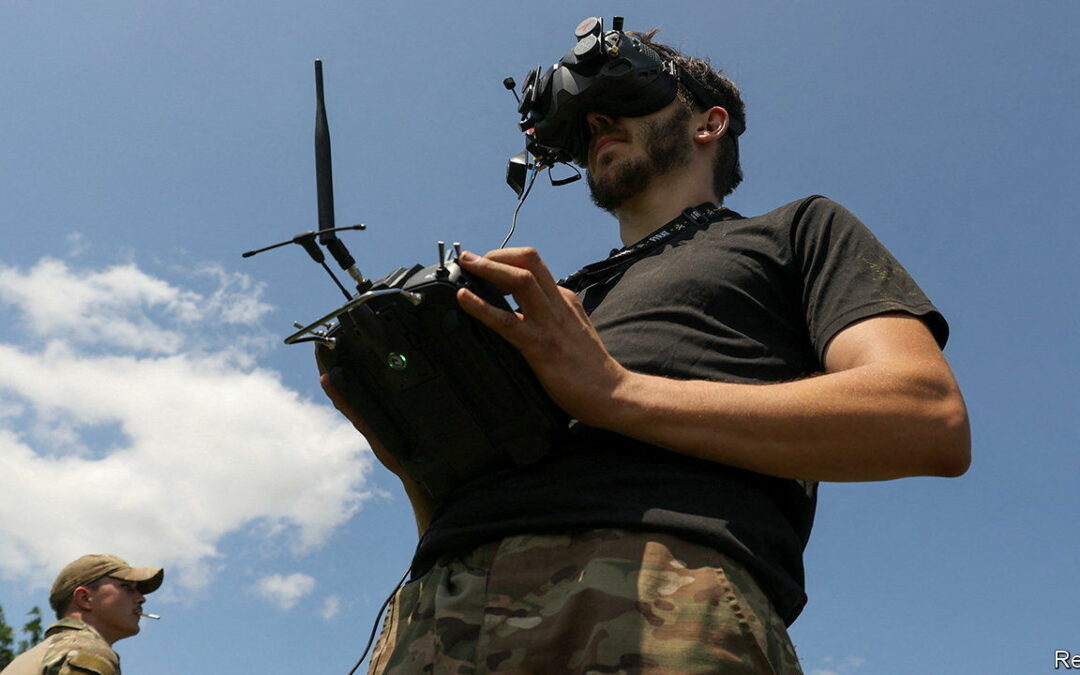A YEAR AFTER they were invented, both sides in Ukraine are already fielding thousands of racing drones with improvised warheads. Ukraine’s defence ministry calls them kamikazes, because the warhead destroys the drone itself. They are also known as First Person View (FPV) drones because the operator dons goggles that show a video feed from them as they fly. They can carry out strikes that would be out of reach of other weapons. In one clip that has been posted online FPVs dive into a tunnel to attack a Russian tank. In others they race after and destroy speeding vehicles. Faster, nimbler and cheaper than regular drones, they could transform warfare, claim analysts. How?
Armies have for a while been using consumer quadcopters, which fly themselves, to drop grenades. FPVs require a skilled remote pilot and are built for speed and manoeuvrability. They loiter as well as fly. The Ukrainians invented homemade versions of these munitions, which are now being copied by the Russians. They are assembled by volunteers or by the soldiers themselves from components provided by fundraisers. The simplicity of the electronics and use of commercial components means that they are cheap to make. One Ukrainian-made Pegasus attack drone costs $462 to buy. The larger and more refined SwitchBlade drones that America supplies to Ukraine, which carry only a small antipersonnel warhead, cost $52,000 apiece or more. FPVs’ low cost compensates for their relatively low rate of success in destroying targets. Operators put their success rate at 50%-80%, compared with 90% or more for American Javelin anti-tank missiles.
Although FPVs do not have a long range, the live-feed to the operator’s goggles allow them to reach beyond the line of sight, hitting targets behind trees, buildings or ridges or in trenches. They can thus supplement artillery attacks. Defenders find it hard to jam them electronically, because they use analogue video signals to fly at low altitudes. FPVs can carry larger warheads than small quadcopters. An FPV warhead is usually not big enough to penetrate a tank’s thick frontal armour, but can go through its thinner rear or sides. It can easily stop lighter armoured vehicles such as personnel carriers, self-propelled guns and trucks. Sergio Miller, a former British Army officer, says that FPVs, if deployed in large numbers in Ukraine, could play the role that the machinegun did in the first world war: make any advance suicidal and lead to stalemate.
Escadrone, a Ukrainian non-profit organisation, produces around 1,500 a month and plans to increase output. Training enough operators will be more difficult. Operating an FPV requires dexterity and fast reflexes. Training In Ukraine, carried out by private schools, NGOs and others, takes a month. The pass rate is 60-70%, although candidates with video-game skills do better. Archangel, a Russian volunteer group that includes programmers, engineers and drone instructors, claims it can train FPV operators in just two weeks.
More uses may emerge as FPVs evolve. New models appear every few weeks. Both Ukraine and Russia have started employing FPV dive bombers, which are able to attack many times. On July 26th Ukraine’s minister for digital transformation announced that the latest additions to an initiative dubbed by the government “the Army of Drones” had artificial intelligence to help locate Russian targets, raising the possibility of autonomous FPVs that do not require a skilled operator, are immune to radio jamming and can be launched in swarms. That could help raise their success rate.
Other armies are showing interest, too. In November America’s Department of Defence issued a request to defence contractors for information based on the Ukrainian experience. NATO’s armies, which require stringent certification of components, may not quickly adopt the technology. But countries with smaller defence budgets and, more worryingly, non-government actors, may be keen to learn from the Ukrainians. ■









